
Preeclampsia
Preeclampsia is the medical term for a pregnancy disorder that appears when a woman is 20 weeks pregnant. It refers to a certain problem with placenta. This condition is characterized by high blood pressure and excessive amount of protein in a woman’s urine. At the beginning, the blood pressure is not very high, but when preeclampsia is untreated, it progresses and can cause very serious complications for the mother and for the child.
Preeclampsia can be mild, moderate or severe. The most common symptoms of this disease are hypertension, proteinuria or excessive levels of protein in the urine and edema or fluid retention. Some women may experience severe headaches, or nausea and vomiting. Certain problems with eyes may occur, such as blurred vision, temporary loss of vision or hypersensitivity to light. Moreover, there are cases where upper abdominal pain on the right side appears. Dizziness, reduced urination and sudden gaining of weight may occur as symptoms of preeclampsia. Sometimes, this disease is accompanied with swelling of the hands and face.
Causes of preeclampsia
Why preeclampsia occurs and what causes it is not still completely understood. Yet, there are some potential causes for the occurrence of this condition. Many experts claim that preeclampsia occurs because of the blood vessels in the placenta, which is the organ that connects the blood supply of the mother to the blood supply of the unborn baby. Through the bloodstream the baby gets necessary food and oxygen, while the baby can pass the waste products back to the mother. Therefore, the placenta requires a great and constant supply of blood from the mother. In the case of preeclampsia, the placenta does not receive enough blood, which may happen because the placenta is not well-formed at the beginning of the pregnancy.
In the first stage of pregnancy, the fertilized egg is implanted in the wall of the uterus and this fertilized egg then manufactures outgrowths named villi to fasten itself to the wall. There are arteries in the wall of the uterus in the shape of spiral that feed the villi and eventually, villi will grow into the placenta. If these spiral-shaped arteries do not become wider and carry enough blood, the placenta may not develop properly. Thus preeclampsia may occur. Disrupted blood flow between the mother and the baby may cause high blood pressure and also affect the kidneys function. The problem with the placenta means that the blood supply between the mother and the baby is disrupted. Signals from the damaged placenta affect the blood vessels, causing hypertension (high blood pressure). The signals also disturb your kidney function, because waste products that should be eleminated from the mother’s blood through the urine, stay in the blood. Simultaneously, important proteins that should stay in your blood go into your urine, causing proteinuria.















Your thoughts on this
Loading...